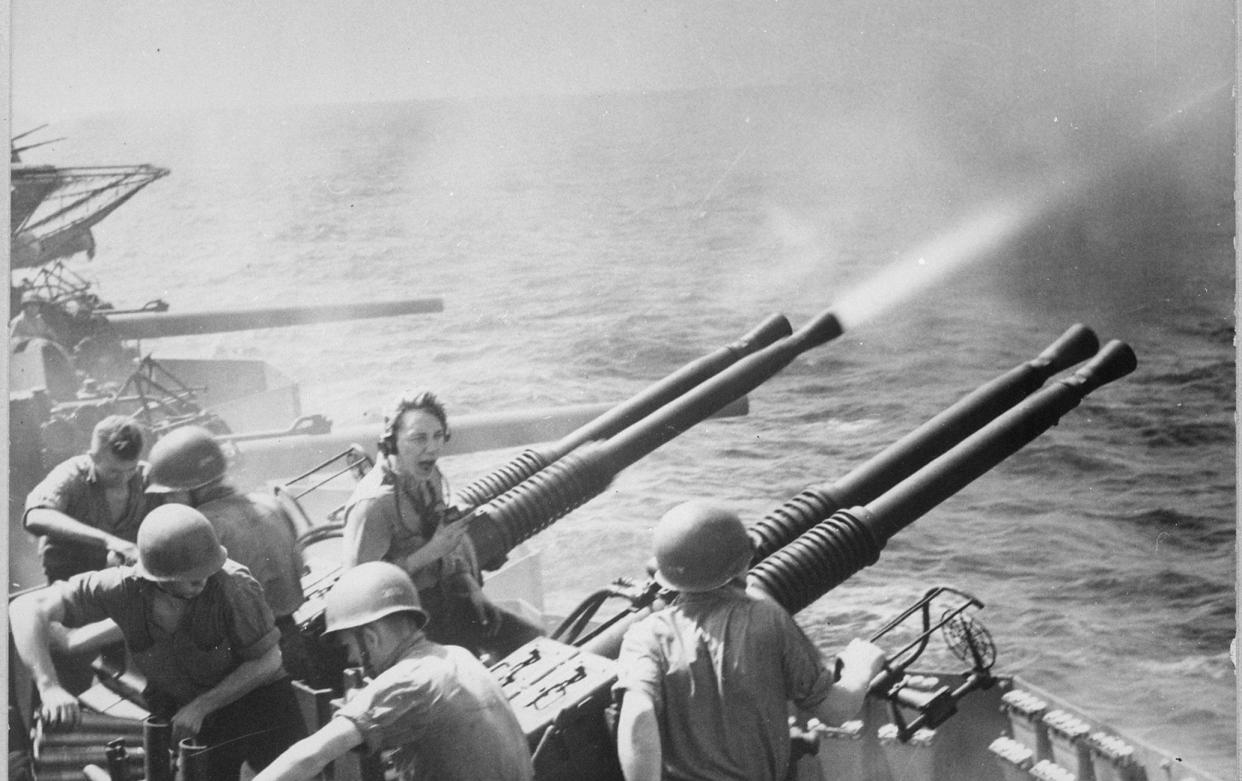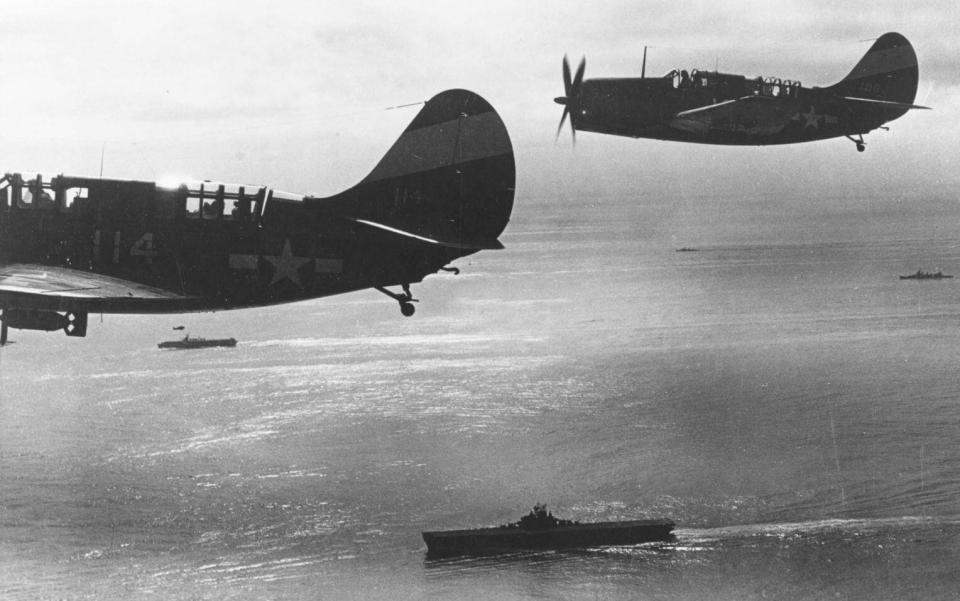The US Navy task force that crushed Japan and let America rule the waves

- Oops!Something went wrong.Please try again later.
- Oops!Something went wrong.Please try again later.
At a critical moment during the Battle of the Philippine Sea in June 1944, the order was given for the blacked-out US aircraft carriers to turn on their lights to assist American pilots returning to their ships in the dark. “We stood open-mouthed on the deck for a moment,” wrote one naval officer, “at the sheer audacity of asking the J-ps to come and get us, then a spontaneous cheer went up… Let them come if they dared. J-ps or no J-ps, the Navy was taking care of its own; our pilots were not expendable!”
Despite the lights, more than 80 American planes ran out of fuel and crash-landed in the sea, though many air crew were rescued. But the battle overall was a crushing victory for the US Navy’s Task Force 58 – made up of 16 aircraft carriers, 1,000 combat aircraft and an armada of escorts – which had just completed an epic 3,500-mile dash across the Central Pacific to crush, once and for all, Japan’s carrier-borne air power, and establish for the United States a maritime supremacy that it still enjoys today.
A vital chapter of naval history, it has been often overshadowed by the better-known battles of Coral Sea, Midway and Leyte Gulf. That should change thanks to Evan Mawdsley’s impeccably researched and compellingly argued study of the men, machines and logistical backup that made it all possible. Supremacy at Sea opens with the naval battle of the Santa Cruz in late October 1942, during the epic struggle for Guadalcanal island, when the US Navy lost one of its last two operational carriers in the Pacific, and the other suffered serious damage. This was arguably the nadir for the US Navy as it tried to take on the Imperial Japanese Navy with a tactical, technical and numerical inferiority in terms of ships and planes. “In the battle of 26 October,” Mawdsley writes, “the US Navy had been outnumbered and outfought.”
Its recovery was partly down to new equipment: the arrival, from the summer of 1943 to the spring of 1944, of 16 new aircraft carriers, seven of which were of the large 27,000-ton Essex class; and a new generation of faster, more agile and more robust planes, including the Grumman Hellcat fighter-bomber. Just as significant, however, were two key appointments at the top of the pyramid: rear admiral Marc (“Pete”) Mitscher, who became the commander of Task Force 58 in January 1944; and his boss, vice-admiral Raymond Spruance, commanding the US Fifth Fleet.
Mawdsley provides excellent pen-portraits of both men: the cautious, genteel Spruance who did well at the Annapolis Naval Academy, worked his way up through big gunships and was fortunate to be given credit for the great US victory at Midway in June 1942; and risk-taking Mitscher, the scion of German immigrants from frontier Oklahoma, who needed two attempts to graduate from Annapolis 107th out of a class of 130. Both were “taciturn”, says Mawdsley, though “Mitscher was a more aggressive tactician, less averse to risk, while Spruance could be seen as a manager with a wide range of responsibilities and a longer-term perspective”.
Also critical to the success of the fast-carrier force was the extraordinary logistical support provided by the “fleet train”, a huge number of supply and support ships that operated from advanced naval bases set up on islands recently captured from the Japanese in the mid-Pacific. This allowed Spruance’s fleet to remain “at sea and in action” for extended periods of time not seen since the age of sail.
By June 1944, Task Force 58 had advanced from the Marshall to the Mariana Islands, the latter just 1,500 miles from the Japanese archipelago, to support the landings on Saipan. It was opposed at the Battle of the Philippine Sea – the largest carrier-versus-carrier battle in history – by almost the whole of the Imperial Japanese Navy’s mobile fleet, which planned to knock out American air-power by launching long-range carrier aircraft strikes against the American flat-tops, and then mopping up the remaining surface ships.
The strikes failed because of superior American radar, fighter direction, anti-aircraft fire, planes and even pilots. In what became known as the “Great Marianas Turkey Shoot”, more than 300 Japanese planes were shot down on June 19, inflicting damage on the Japanese Navy’s carrier squadrons that was “terrific and irreversible”. American losses were negligible: a handful of planes, and not a single ship seriously damaged.

A day later, having finally located the Japanese carriers, American air strikes were launched too late in the day to be effective – only a single escort carrier was sunk – and many planes were lost as they ran out of daylight and fuel. But Mitscher’s blushes were spared when he learned that two of Japan’s best aircraft carriers had been sunk on June 19 by American submarines. While often seen as a triumph of carrier aviation, the battle was rather a “combined arms” effort, “with the submarine playing a crucial role in both reconnaissance and attack”.
The main controversy of the battle was Spruance’s refusal on June 18 to allow Mitscher to move his carriers west into a position from which he believed – correctly, as it turned out – that he could launch air strikes on the Japanese carriers the following morning. Determined to protect the amphibious forces at Saipan, Spruance was playing it safe. “Mitscher’s hunch was right,” Mawdsley writes. “Spruance’s was wrong. Neither man was ignoring convincing evidence.”
A former professor of international history at the University of Glasgow, Mawdsley is that rare breed: an academic who writes as fluently about combat as he does about logistics. In Supremacy at Sea, he has produced an important, insightful book about the most powerful naval force in history, and the battle that ushered in “a new global era of sea power”.
Saul David’s books include Sky Warriors: British Airborne Forces in the Second World War. Supremacy at Sea: Task Force 58 and the Central Pacific Victory is published by Yale at £20. To order your copy for £16.99, call 0808 196 6794 or visit Telegraph Books

